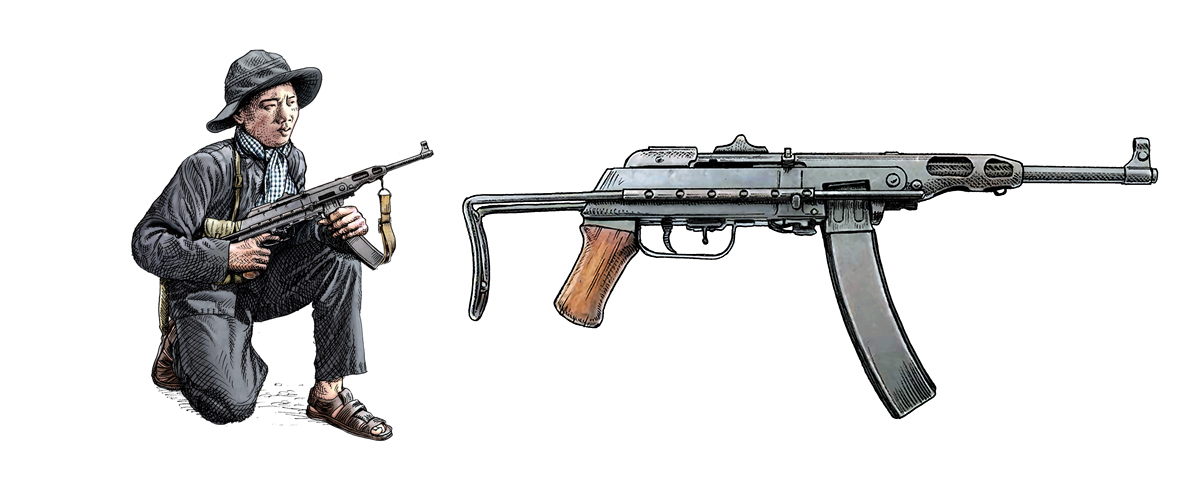Prior to receiving large-scale shipments of AK-47 and RPD machine guns, the North Vietnamese Army (NVA) was equipped with a variety of captured and supplied weaponry. Chinese-supplied variants of Soviet weapons was a main source, but the North Vietnamese didn’t trust their socialist allies and worked to develop their own arms industry. The first of these indigenous weapon designs was the K-50M submachine gun. Essentially a variant of the Soviet PPSh-41, the K-50M drew upon Hanoi’s experience with captured French weapons, especially the MAT-49 submachine gun. The K-50M fired the same 7.62x25mm round as its Sino-Soviet parents, but replaced the wooden stock with a sliding wire butt derived from the French gun. The Vietnamese also cut the cooling sleeve by nearly three inches, faired it in the barrel and removed the muzzle compensator that was intended to limit barrel climb during automatic fire. They tap welded a front sight on the barrel’s end and added a wooden pistol grip. The resulting gun was four inches shorter and two pounds lighter than its Soviet and Chinese counterparts. Although designed to go with a curved 35-round magazine, it could also use the PPSh-41’s 71-round drum.
 Production ran from 1958 to 1964. The first models were captured in South Viet-nam in 1963. Like the designs on which it was based, the K-50M was a conventional blowback operated submachine gun that fired over an open bolt. A simple lever forward of the trigger enabled the soldier to shift from automatic to semi-automatic firing mode. It had an open-leaf sight that could be set for 100 or 200 yards. Most of the weapon’s components were forged or stamped, and its manufacturing was simple, fast and inexpensive, involving very little machining. Most fixtures were tap welded into place. Many of the K-50Ms were made by local workshops that modified readily available Chinese Type 50 or Soviet PPSh-41 submachine guns.
Production ran from 1958 to 1964. The first models were captured in South Viet-nam in 1963. Like the designs on which it was based, the K-50M was a conventional blowback operated submachine gun that fired over an open bolt. A simple lever forward of the trigger enabled the soldier to shift from automatic to semi-automatic firing mode. It had an open-leaf sight that could be set for 100 or 200 yards. Most of the weapon’s components were forged or stamped, and its manufacturing was simple, fast and inexpensive, involving very little machining. Most fixtures were tap welded into place. Many of the K-50Ms were made by local workshops that modified readily available Chinese Type 50 or Soviet PPSh-41 submachine guns.
Most of the K-50M parts were interchangeable with those of the Type 50 and PPSh-41 submachine guns. Some, however, lacked the laminated felt or leather buffer mounted behind the breech block to absorb the weapon’s recoil. That and the lack of a muzzle compensator reduced accuracy and placed a premium on burst control. However, Viet Cong tactics called for close-in engagements, usually at ranges below 50 yards. At those ranges, the gun’s high rate of fire compensated for loss of accuracy. The rounds it fired were not as powerful as those fired by its American counterparts, but the ammunition and related magazines were lighter, enabling soldiers to carry more of them. Moreover, NVA leaders believed the volume of fire it delivered at close range provided more than enough punch to win most firefights. Few that faced them in the jungle would argue that point.
North Vietnam needed a weapon that was light, robust, easy to maintain and required little training to master. The K-50M sub-machine gun met that need independent of foreign supply sources.
This feature originally appeared in the December 2011 issue of Vietnam Magazine. Subscribe today!





